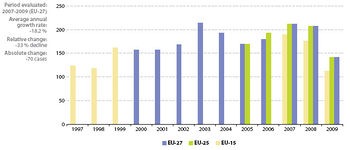Archive:Sustainable development - good governance
- Data from July 2011, most recent data: Further Eurostat information, Database.
This article provides an overview of statistical data on sustainable development in the area of good governance. They are based on the set of sustainable development indicators the European Union (EU) agreed upon for monitoring its Sustainable development strategy. Together with similar indicators for other areas, they make up the report 'Sustainable development in the European Union - 2011 monitoring report of the EU sustainable development strategy', which Eurostat draws up every two years to provide an objective statistical picture of progress towards the goals and objectives set by the EU sustainable development strategy and which underpins the European Commission’s report on its implementation. More detailed information on good governance indicators, such as indicator relevance, definitions, methodological notes, background and potential linkages, can be found on page 339-359 of abovementioned publication.
The table below summarises the state of affairs of in the area of good governance. Quantitative rules applied consistently across indicators, and visualised through weather symbols, provide a relative assessment of whether Europe is moving in the right direction, and at a sufficient pace, given the objectives and targets defined in the strategy.
Overview of main changes
The trends observed in the good governance theme since 2000 have been mixed. There have been favourable trends as regards infringement cases as well as e-government availability and usage. In addition, the transposition of EU law has been above the target rate. There have, however, been negative trends with regard to voter turnout in national parliamentary elections, which is generally falling. Moreover, trends in the ratio of environmental to labour taxes show that a general shift towards a higher share of environmental taxes in total tax revenues has not been achieved.
Main statistical findings
Headline indicator
Policy coherence and effectiveness
Citizens' confidence in EU institutions
The European Parliament continues to be the most trusted among the main EU institutions, followed by the European Commission and the Council of the European Union. Trust levels for all three institutions in the EU have, however, dropped in 2009 compared to the levels in 2007
In 2009 half of the EU citizens who were interviewed said that they trusted the European Parliament, making it the most trusted of the three main EU institutions. Fewer citizens said that they trusted the European Commission (46 %) and the Council of the EU (41 %). Since 2007, however, trust levels for all three institutions have decreased in the EU as a whole. Trust in the European Parliament has declined by 9.1 %, in the Commission by 8 %, and in the Council by 6.8 %.
Confidence in the three main EU institutions has developed in parallel since 1999, with the level of trust in each institution remaining approximately the same over the entire period [1].
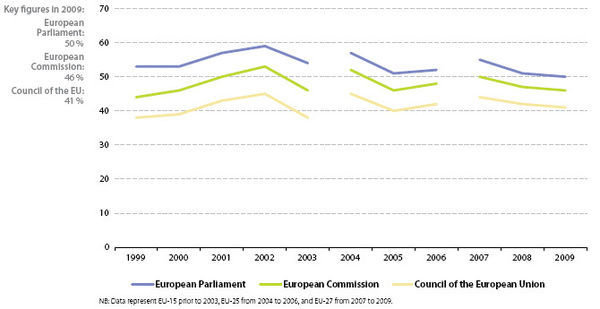
Infringement cases
The number of new infringement cases in the EU decreased considerably between 2007 and 2009
- More than 50 % of new infringement cases in 2009 concerned Environment, Health and Consumer Protection and
Internal Market
There was a considerable decrease of new infringement cases in the EU between 2007 and 2009. Whereas cases decreased only slightly between 2007 and 2008 (from 212 to 207), the drop between 2008 and 2009 was substantial (from 207 to 142). This was mainly due to a reduction of new cases in two policy areas: Internal Market, which had an exceptionally high number of cases in 2008 (71 cases, compared to about 30 cases in 2007 and 2009), and Justice and Home Affairs, which showed a notably high number in 2007 (77 cases, compared to 38 in 2008 and 14 in 2009).
There are also considerable differences among the individual policy sectors. Environment, Health and Consumer protection (31.5 %) and Internal market (19.6 %) still made up more than half of all new infringement cases in 2009. Between 2008 and 2009 new infringement cases decreased in seven policy sectors, increased in two sectors and remained the same in another two sectors.
The number of infringement cases in the EU-25 has increased from 170 to 207 between 2005 and 2008. The situation among policy areas varies, and just three predominate
72% of cases concern internal market, environment, health and consumer protection, and justice and home affairs
Between 2005 and 2008, the number of infringement cases in the EU-25 increased by an annual average growth rate of 6.8 %. However, the number of cases varied substantially from one year to the next. In 2008, 207 cases, where a Member State had failed to fulfil its obligations, were brought before the European Court of Justice. This marks a slight decrease compared to 2007 with 212 cases.
The situation varies considerably between the different policy areas and three areas in particular have predominated: internal market; environment, health and consumer protection; and justice and home affairs. In 2008, these three areas out of eleven made up 72 % of all actions for failure. 71 actions were linked to the internal market, 49 actions to environment, health and consumer protection, and 31 actions to justice and home affairs.
Transposition of Community law


The implementation of Community law into national law has slightly increased in the EU-25 between 2004 and 2008. The transposition level has been above or almost on the target rate since 2005, but has remained below in several policy sectors
Transposition of Community law was right on target in EU-27 in 2008
The indicator measures the percentage of EU Directives for which measures of implementation in national law have been undertaken. In 2001, the European Council set the target of a 98.5 % rate of transposition of Community law by national authorities. Between 2004 and 2008, the share of implemented Directives in the EU-25 increased on average by 0.15 percentage points per year. Between 2007 and 2008, the transposition level decreased in the EU-27 from 99.3 % to 98.5 %, but has remained right on target.
Six out of ten policy sectors have been below target
All policy sectors have now reached transposition rates above 95 % and these rates have increased since 2004, with the exception of energy and transport, and taxation and customs union. In 2008, the transposition levels were below the EU-wide target of 98.5 % in six sectors.
Openness and participation
Voter turnout
Participation in national parliamentary elections in the EU-27 has decreased between 2000 and 2008. However, the turnout has been generally higher than in EU elections
Voter turnout in national parliamentary elections has decreased

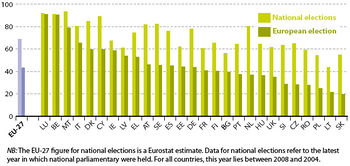
When comparing the voter turnout in national parliamentary elections in the EU-27 between 2000 and 2008, participation has slightly decreased by an annual average rate of 0.3 % from 70.3 % to 68.5 %. It has decreased in most Member States during this time period, but has remained above 50 % in all countries except for one.
Participation in EU elections has been considerably poorer than in national elections
Participation in EU parliamentary elections has been considerably lower than in national elections. In 2009, voter turnout in the EU elections has been 43 % and has thus been lower than in the previous elections in 2004 with 45.5 % and 1999 with 49.5 %. Looking at the results for the 2009 EU election in the individual Member States, turnout remained below 50 % in 18 countries, and was above 50 % in nine countries. The poorer voting record for the EU parliament than for national parliaments – more than 20 % less in 18 countries – may reflect a lack of information on EU matters among EU citizens [2] as well as the fact that EU elections may not be perceived by citizens as having much impact on national (and personal) interests.
E-government availability
The offer of on-line public services has steadily increased in the EU-25 since 2004, reaching 62% in 2007. It varies however considerably among Member States
The on-line availability of public services in the EU is 59%
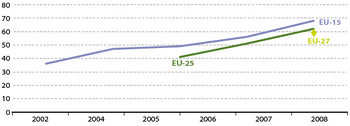
E-government on-line availability is widespread in the EU. In the EU-25 the average annual increase was as high as 14.8 %. The value for the EU-27 in 2007 shows an on-line availability of public services of 59 %. The period between 2004 and 2007 has witnessed an increase in 22 countries, no change in two and a decrease in only one.
16 Member States offer 50% or more basic services online
The quantity of online services offered varies considerably among Member States. In 2007, six countries had between 75 and 100 % of basic public services fully available online, nine offered between 35 and 50 %, and two only between 15 and 25 %. In the latest review of the EU’s ‘i2010’ policy framework [3], the Commission presented progress in the areas of e-government and e-health and concluded that ‘Europe continues to make progress in the supply of online public services and thereby is making major steps towards the goals of the Lisbon Strategy and the i2010 eGovernment action plan’.
E-government usage
The use of on-line public services increased significantly in the EU-27 from 2005 to 2008, but varied considerably between countries. Overall, close to a third of EU citizens used e-government in 2008
E-government usage is generally on the rise, but fell in 2008

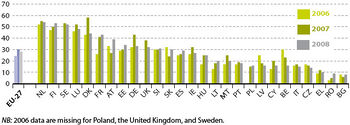
Between 2005 and 2008, e-government usage by individual citizens in the EU-27 has increased at an annual average growth rate of 6.8 %. However, there has been some fluctuation in the usage during these years, and compared to 2007, the 2008 value has fallen by two percentage points.
Usage varies between 8 and 53% among Member States
In 2008, more than 50 % of the people used the internet for interaction with public authorities in three countries (Netherlands, Finland and Sweden). In 14 Member States, individual usage was between 50 and 20 %, and in ten it was below 20 %. Therefore, similar to e-government availability, e-government usage varies substantially between Member States. One reason for this difference may be that some have lower coverage of high-speed internet connections and generally lower degrees of computer access.
E-government availability and usage are not related
There is no direct connection between the offer of online public services and e‑government usage. In 2007, e-government availability in the EU-27 was 59 %, while e-government usage was 30 %. Only some States, such as Sweden, Finland, the Netherlands and Denmark have reached a high level of both e‑government availability and e-government usage.
Economic instruments
Environmental taxes compared to labour taxes
The ratio of environmental to labour taxes decreased slightly in the EU-27 from 2000 to 2007. By and large, there has been a slight shift from environmetal to labour taxes
The ratio has slightly shifted to the disadvantage of environmental taxes


The ratio of environmental to labour taxes has decreased from 0.134 in 2000 to 0.127 in 2008 with an annual average decrease of 0.7 %. There has therefore been a slight shift from environmental taxes to labour taxes.
The share of environmental taxes has declined
The share of environmental taxes in total tax revenues fluctuated slightly between 2000 and 2007. It peaked in 2002 and 2003 at a level of 6.9 % and had its lowest value in 2007 at 6.2 %. Looking at the share of environmental taxes in the individual countries, only two show a share above 10 % of total tax revenue, while in eight the share has been below the EU-27 average of 6.2 %. The decline in the share of environmental taxes in recent years may be partly attributed to greater reliance on instruments other than taxation in environmental policy, such as emissions trading [4]. Additionally, in many Member States renewable energy sources are either subject to lower tax rates than exhaustible energy sources, or altogether exempted from other incentives to switch from fossil fuels towards more environmentally-friendly energy sources. Thus, a country with a large share of renewable energy may still have a lower share of environmental taxes than another country which has not changed towards more environmentally-friendly energy.
The share of labour taxes has also decreased
Generally, the taxation on labour is much higher in the EU than in other major industrialised economies [5]. As with environmental taxes, the share of labour taxes in total tax revenues fluctuated between 2000 and 2007. The highest share was in 2003 (51.1 %) and the lowest in 2007 (48.7 %). However, despite the widespread consensus in the EU on the desirability of lower taxes on labour and the fact that a majority of the Member States had a decreasing share of labour taxes in 2007 compared to 2000, the level of the implicit tax rate on labour was still rising, thus confirming the widespread difficulty in achieving the aim of lower labour tax rates [6].
Further Eurostat information
Publications
- Energy, transport and environment indicators - Pocketbook, 2009
- Panorama of energy: Energy statistics to support EU policies and solutions - Statistical book, 2009
- Sustainable development in the European Union - 2009 monitoring report of the EU sustainable development strategy
Database
- Good governance (Theme 10)
- Policy, coherence and effectiveness
- Openness and participation
- Economic instruments
Dedicated section
Other information
- Europe's Digital Competitiveness Report: Main achievements of the i2010 strategy 2005-2009, Commission Staff Working Document COM(2009) 390
- European governance - A White Paper, European Commission, COM/2001/ 428
- Mainstreaming sustainable development into EU policies: 2009 Review of the European Union Strategy for Sustainable Development, Commission communication COM(2009) 400
- Strategic report on the renewed Lisbon strategy for growth and jobs: Launching the new cycle (2008-2010). Keeping up the pace of change, Commission communication COM(2007) 803
- Taxation trends in the European Union: data for the EU Member States and Norway, 2009 edition, European Commission
- The user challenge: Benchmarking the supply of online public services. 7th Measurement, Capgemini, European Commission, Brussels, 2007
External links
- European Commission - Sustainable Development - The renewed European Sustainable Development Strategy 2006
- OECD - Public Governance and Management
- United Nations - Global issues - Governance
See also
Notes
- ↑ European Commission, Eurobarometer 72, Brussels, 2010
- ↑ Farrell, D.M. and Scully, R, Representing Europe’s citizens? Electoral institutions and the failure of parliamentary representation, Oxford University Press, Oxford,fckLR2000
- ↑ European Commission, Preparing Europe’s digital future – i2010 Mid-Term Review, SEC(2008) 470
- ↑ European Commission, Taxation trends in the European Union: data for the EU Member States and Norway, 2009 edition, Luxembourg, Office for Official Publications of the European Union, 2009, pp. 109-13.
- ↑ European Commission, Taxation trends in the European Union: data for the EU Member States and Norway, 2009 edition, Luxembourg, Office for Official Publications of the European Union, 2009
- ↑ European Commission, Taxation trends in the European Union: data for the EU Member States and Norway, op. cit.


